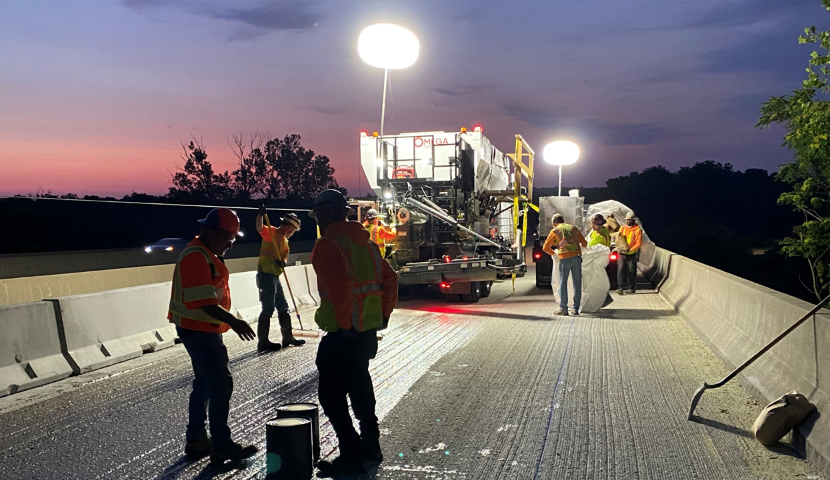“When an engineer has built a bridge, the fact that a cat can pass over the bridge is no proof that the bridge is good. A train must pass over it to prove its strength.” — Richard Wurmbrand
What do you do when working with concrete that has no water or cement? Concrete of a type that your company has never used? How do you approach working with concrete that has warning labels on every component?
Why We Don’t Handle It As Normal Concrete
I participated this summer in restoring a bridge in Fenton, Missouri, with a concrete overlay. The concrete—Hybrid Composite Synthetic Concrete (HCSC)—used no Portland cement or water. Instead, the binding agent in HCSC is resin. The company doing the work had never used this material before and had only observed HCSC being placed for a few hours.
I worked with the on-site safety manager to devise an action plan. After examining the safety data sheets (SDSs) and product data sheets with storage recommendations, we determined that all materials must be protected from rain and sunlight but would be safe to store outside if covered.
The recommended PPE for handling the HCSC components was gloves, eye protection, and protective clothing. The manufacturer’s representative recommended that cleanup of all equipment, tools, and skin (if necessary) be with an acetone spray. The manufacturer’s representative did not recommend water for cleaning up either the primer or the binder resin because water is an inadequate cleaning solvent.
What Makes HCSC Worth the Trouble?
When I joined the project team, one of my first questions to the project manager was “What makes this material so special.” I learned that HCSC is much stronger and more resistant to deicing chemicals than typical concretes. HSCS reportedly deteriorates at a much slower rate than typical concretes because there is no water in the concrete to erode with de-icing salt. A value engineering study showed that the material would be more effective in the long term due to its high-performance capabilities.
Hazards of the HCSC Components
There are three components of HCSC that each have their own hazards: primer, binder resin, and aggregate.
The primer is an initial coat applied to the existing concrete so the new concrete will bond to it. As shipped, the primer is inactive. The addition of a second material activates the primer. The activated primer can cause extreme irritation when in contact with skin or inhaled and requires immediate treatment. The SDS for the primer states that the material emits irritating fumes when heated and recommends that workers avoid breathing any fumes when handling the primer. It also recommends cleaning all contaminated clothing before reuse. As for primer storage, the SDS recommended storing it in a cool, dry, well-ventilated location away from extreme heat or direct sunlight.
HCSC Binder Resin holds aggregate together to form an extremely strong concrete. This binder resin comes in 250-gallon totes and is labeled as flammable and as an eye and skin irritant. Further, binder resin may undergo hazardous polymerization. Due to these special hazards, the driver hauling the liquid must have a CDL with a hazardous material endorsement.
When handling the binder resin, it was important to protect against contact with the material. Before mixing, the only handling was to connect the resin tote to the volumetric truck. The resin is very sticky and water-resistant, which made any contact with this material difficult to remove without acetone.
The aggregate is delivered in preblended bags containing small rocks, sand, and basalt fibers. The basalt fibers can be extremely irritating because they make micro cuts in the skin. Again, it was important to protect against contact with the material. While there was minimal skin contact with this material as it was transferred into the volumetric truck. workers were still required to wear gloves and clothing with long sleeves to avoid irritation.
What About After the HCSC Concrete is Mixed?
Once combined, HCSC requires handling methods similar to those for handling Portland concrete. The following safety measures should be taken for all concrete handling:
- Wear protective gloves when handling any concrete.
- Wear steel-toe shoes that have a material resistant coating.
- Wear eye protection when handling any concrete.
As with Portland concrete, an exothermic reaction within the HSCS causes it to become warm as it cures. However, it does not get hot enough to cause harm. Once HSCS has cured enough to walk on, its components have become inert and will not cause harm by contact.

Photo credit: McKenna Schneider, 13-Jun-2023
Training to Handle and Storing New Materials
Working with HSCS was a learning curve for project team members at all levels. This experience forced the company to consider and adapt to new safety concerns. We should expect that other new materials will have their own hazards. We should train for work with new materials before encountering the material in the field.
Training sessions for working with a new material are required for the entire project team, not just some. There is no reason for a laborer to unknowingly have a material burning off the soles of his shoes.
In the end, we completed the project per the specifications. Traffic across the bridges reopened, making for happy drivers. Drivers who have no idea of the novel materials they are driving across..
Although I have seen neither cats nor trains crossing the bridge over the Meramec, I will confidently drive over the bridge I helped to restore.
[Note: The Hazard Communication Standard, 1910.1200, is a general industry standard. The construction industry follows 1926.59, which states “Note: The requirements applicable to construction work under this section are identical to those set forth at §1910.1200 of this chapter.”]
